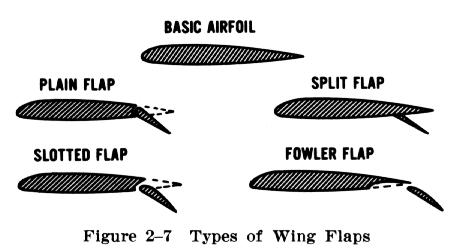
Wing flaps, installed on the wings of most modern airplanes, have two
important functions. First, they permit a slower landing speed and, therefore,
decrease the required landing distance. Second, because they permit a comparatively
steep angle of descent without an increase in speed, it is possible, while
making maximum utilization of the available landing area, to safely clear
obstacles when making a landing approach to a small field. They may also
be used to shorten the takeoff distance and provide a steeper climb path.
| Most wing flaps are hinged near the trailing edges of the wings, inboard of the ailerons (Fig. 2-7). They are controllable by the pilot either manually, electrically, or hydraulically. When they are in the up (retracted) position, they fit flush with the wings and serve as part of the wing's trailing edge. When in the down (extended) position, the flaps pivot downward from the hinge points to various angles ranging up to 40° - 50° from the wing. This in effect increases the wing camber (curvature) and angle of attack, thereby providing greater lift and more drag so that the airplane can descend or climb at a steeper angle or a slower airspeed. |
 |